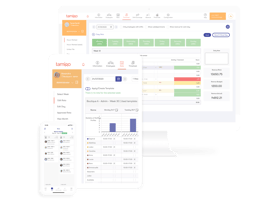Welcome to our Upgrade your workforce management series. It’s where we explore switching to a cloud-based solution, and what that process looks like in practice for retail and hospitality companies.
In this article, you’ll learn how to find the right solution for your business.
Still wondering about the benefits of upgrading? Check out 3 reasons to automate your workforce management.
Choices, choices
You’ve probably heard of ‘the paradox of choice’. Coined by author Barry Schwartz, it’s the idea that having more options isn’t always a good thing. We become overwhelmed with the choices on offer and worry that we'll make the wrong one.
If you’re on the hunt for a new workforce management (WFM) solution, this may be ringing some bells. The workforce management market is booming; by 2026 it will be worth USD 18.8 billion. As a result, there's a lot of solutions to choose from.
After 15 years in business, we’ve learnt some things about matching companies and solutions. One thing we always recommend our retail and hospitality clients? Sidestep the paradox of choice with preparation.
It’s about going into the selection process with your eyes open, all your stakeholders bought-in and your requirements clearly defined. This focuses your efforts on software that's truly a good fit.
The 7 steps for getting ready
We call this prep work the ‘pre-decision making’ stage. In this article, we'll break it down into 7 manageable steps.
1. Identify what you want to achieve
Before you begin your search for a new solution, it’s important to understand what you want to achieve with your investment.
- Are you trying to improve employee experience?
- Do you want to monitor a new set of KPIs
- Would your team benefit from greater transparency across your chain?
Being fully aware of your unique needs and ambitions will help you match with a platform’s offering and USPs.
2. Align your KPIs
It’s time to gather your decision makers to talk KPIs — what are they for your business and do you define them?
For instance, productivity is typically a main KPI in hospitality and retail, but what does it mean to your company? Do you include training exercises as productive hours? What about stock take or admin that’s carried out in the back office?
You can learn more about this in our article KPIs for retail: which ones should you measure.
Drilling down into your KPIs before implementation allows you to review your current ways of working. And better understand how and why you can improve these processes with a new solution.
3. Consider the support you need
If you’re an international company (or plan to be), think about how a solution will work across borders. Does it come in the languages all your staff speak? Is there support available for questions around local labour laws and requirements?
Finding a platform that caters to international clients can ensure fast adoption amongst your staff. And gives your company peace of mind around compliance.
4. Look to the future
When shortlisting solutions, you need to seek out a platform that can scale alongside you. In two years’ time, will it still be a great fit – or will you have to start the process over again in search of a more enterprise-level solution?
To help you make the right choice, create one wish list of features and capabilities you want now, and another for those you would need in the future. Then, compare how your chosen platforms measure up with both your immediate and long-term goals.
Further reading: How Bijou Brigitte save their store managers hours of reporting.
5. Analyse your current tech infrastructure
How will a WFM solution integrate with your existing setup? tamigo fits in snugly between the HR and payroll systems. Facilitating integrations between these two areas drastically reduces time spent on data entry and calculations.
Let’s take a practical HR example. You’re working across markets using the same HR system. But there’s no link between it and your employees’ schedules. All the information you need to add (contract hours, labour law requirements, employee skills) needs to be entered manually into your schedules, as spreadsheets. It takes a lot of work and errors can easily creep in.
Raconteur, a publishing house that specialises in business insights, emphasises the importance of this relationship.
“By having payroll and HR work in closer alignment ... organisations can help to foster the processes and information sharing that will prove pivotal in the effective management of a global workforce.”
With tamigo, you have one smooth transition where you create a user in the HR system. That information automatically flows into your timesheet and attendance solution, and all the data you need is sent to payroll in just one click.
6. Put together the right implementation team
A dedicated and collaborative team will need to oversee the transition.
In many companies, HR, IT and Management aren’t the closest of collaborators. But for this project, you’ll need them all fully on board and working together. You don’t want a situation where one department isn’t happy with the choice of solution.
During her time at Deloitte, Staci Bisher led companies through the adoption of new technologies. She says that empowering stakeholders was key to the process.
“They need to understand their role in change. Which means being a voice and a change agent.”
Build your team with spokespeople from every department. And enable meaningful discussions through meetings or workshops.
7. Start initial change management activity
One of the pitfalls of transitioning to a WFM solution is failing to consider the mindset of your end-users.
Hospitality and retail staff are busy people. Introducing new technology into their already hectic schedules will be challenging. Especially if they haven’t been prepared.
Set yourself up for success by giving your employees a heads up. And instead of relaying your big top-line goals, highlight the direct benefits they’ll receive, such as easier shift swapping, more accurate salary calculations and faster holiday approval.
Ready to upgrade your workforce management? Book your free tamigo demo today. It's your chance to see a solution in action and discuss your business's needs with one of our specialists.






